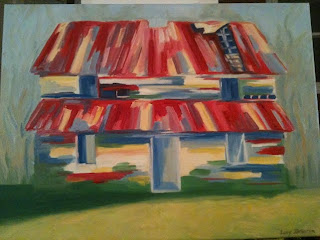Paul Jackson Pollock (January 28, 1912 – August 11, 1956)
An American Abstract Expressionist painter that still captivates me with his techniques of painting, from his (People/figures) imagery purposely in-lined within his abstract action paintings to the free flow of paint from a stick with one single hand motion and the pouring of paint straight from a paint can. His paintings show so much movement, balance, value, texture, color, etc. that it’s amazing to me! Not only his technique captivates me, but the scale of his paintings is astounding!! I was lucky enough to see one of his paintings in Dallas (DMA) “A Dream and Portrait” 1953. The painting was huge!! Took up the whole wall!! Like most of his paintings that are in the size of 8 feet or larger, it takes your breath away.
Just recently, I watched the movie, “Pollock” (2000) played by Ed Harris for the hundredth time. His influence inspires me in creating my own abstract paintings. During my studies on Pollock in college and beyond, he was the first painter that took non-traditional way of painting to a new level. He removed the duck/cotton canvas from a frame and placed on the floor of his studio/barn. Pollock felt more at ease and being part of the painting when it was on the floor in such a large scale. He also didn’t like using the familiar square size of a painting, so he would lay out this large stretch of canvas that extended beyond 4 feet. Pollock used industrial paint, alkyd enamels, or house paints because of the flow of the paint was easier to manage. He also did not use paint brushes during this technique called “Dripping or action painting” instead he would use a painter‘s stick or pour the paint straight from the paint can and even using basting syringes. Pollock would not come in contact with his paintings with a brush, he would sometimes step onto the painting or when he signed them with his hand prints. I also heard that if you look very closely in his paintings, you could find cigarette butts, ashes from the his cigarettes, and even his foot prints in his paintings.
When Pollock was asked about if his paint was controlled or about mistakes made while he was creating this painting technique, in Life Magazine article, he stated that the paint was controlled in some state. For Pollock would dance, walk onto the canvas, view the paintings from all sides and apply the paint where ever the painting wanted him to. The painting itself would speak to him and it would come to life! My favorite answer to his question about, “What happens if you make a mistake”? Pollock answered, “I don’t recognize the mistake, I accept it”. Wonderful! For it was a mistake that he discovered his technique in dripping in his studio by spilling paint on the floor of his studio and went from there. A beautiful mistake!
 |
| A Dream and Portrait 1953 |
































